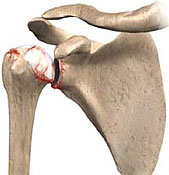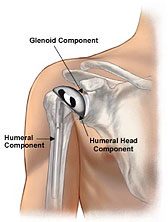Shoulder Arthritis
Shoulder arthritis is a painful condition involving the shoulder. It has several names, including Osteoarthritis, degenerative joint disease, and Rheumatoid Arthritis. Arthritis can occur in any joint in the body. The shoulder is the third most common major joint affected by arthritis, after the hip and the knee. Arthritis usually develops over many years, and often gets worse with time. When it occurs in the shoulder, it results in pain, stiffness (loss of motion), and difficulty with overhead activities. It can also cause crunching, popping, and clicking with movement. Initial treatment focuses on medications and possibly cortisone injections, but surgery may become necessary for removal of bone spurs or even shoulder replacement.
How does this happen?
Arthritis is a degenerative condition that causes loss of cartilage in the joints. The most common form of arthritis is Osteoarthritis, also known as Degenerative Joint Disease, and represents normal wear and tear of joints associated with aging. Degeneration of the joints may also be from Rheumatoid Arthritis, an inflammatory condition, or Post-Traumatic Arthritis, where degenerative changes occur following trauma or broken bones. Arthritis has many contributing factors. It is a normal aging process, and usually gets worse the older we get. It may result from inflammatory conditions (Rheumatoid arthritis) or trauma (broken bones). It can progress faster with repetitive activities, heavy labor, and normal wear and tear. It also runs in families.

Normal Shoulder

Shoulder Arthritis
How will we know that this is your problem?
The diagnosis of shoulder arthritis is made by a combination of history and physical exam. Your doctor should ask you when your shoulder hurts and what makes it better or worse. Examination of the shoulder may reveal pain, stiffness, weakness, and crunching or grinding. Routine X-rays of the shoulder obtained in the office confirm the presence of arthritis. Your doctor may also order a CT scan or MRI for additional information.
How can this be treated?
Dr. O’Brien treats arthritis of the shoulder, and patients of all ages with this condition. Shoulder pain caused by arthritis can be managed initially with medications and cortisone injections, while range of motion and strength can be improved with structured physical therapy programs. Dr. Michael O’Brien also performs surgery for shoulder arthritis, including shoulder replacements, and is fellowship trained in the field of shoulder surgery and shoulder reconstruction. He offers a wide range of surgical reconstruction, including Hemiarthroplasty for young active patients, Total Shoulder Replacement, and Reverse Shoulder Replacement for patients with arthritis and large rotator cuff tears. He aims to get patients back to the activities they enjoy with a painless, functional shoulder.

Shoulder Arthritis



Dr. Michael O’Brien has recent publications in the orthopaedic literature describing his excellent surgical results, and the use of a new, less invasive surgical technique for shoulder replacement (see below).
The Tulane Institute of Sports Medicine offers on-site X-Ray and MRI, as well as its own Physical Therapy department with licensed physical therapists, in order to ease your visit and speed your recovery.
¹ Subscapularis-sparing Deltopectoral Approach to the Shoulder. Techniques in Shoulder and Elbow Surgery. 2010; 11(1):19-24.
²Arthroscopic glenoid resurfacing as a surgical treatment for glenohumeral arthritis in the young patient: midterm results. Arthroscopy. 2009; 25(8):864-71.
³Arthroscopic Approach to Glenohumeral Arthritis in Operative Arthroscopy (4th Ed.), Johnson, DH, Ed., Wolters Kluwer/Lippincott Williams & Wilkins, 2013, pp. 286-296.
